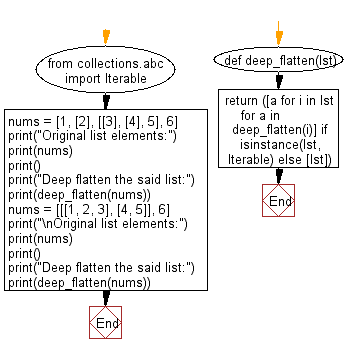Python: Perform a deep flattens a list
Python List: Exercise - 255 with Solution
Write a Python program to perform a deep flattens a list.
- Use recursion.
- Use isinstance() with collections.abc.Iterable to check if an element is iterable.
- If it is iterable, apply deep_flatten() recursively, otherwise return [lst].
Sample Solution:
Python Code:
from collections.abc import Iterable
def deep_flatten(lst):
return ([a for i in lst for a in
deep_flatten(i)] if isinstance(lst, Iterable) else [lst])
nums = [1, [2], [[3], [4], 5], 6]
print("Original list elements:")
print(nums)
print()
print("Deep flatten the said list:")
print(deep_flatten(nums))
nums = [[[1, 2, 3], [4, 5]], 6]
print("\nOriginal list elements:")
print(nums)
print()
print("Deep flatten the said list:")
print(deep_flatten(nums))
Sample Output:
Original list elements: [1, [2], [[3], [4], 5], 6] Deep flatten the said list: [1, 2, 3, 4, 5, 6] Original list elements: [[[1, 2, 3], [4, 5]], 6] Deep flatten the said list: [1, 2, 3, 4, 5, 6]
Flowchart:

Visualize Python code execution:
The following tool visualize what the computer is doing step-by-step as it executes the said program:
Python Code Editor:
Have another way to solve this solution? Contribute your code (and comments) through Disqus.
Previous: Write a Python program to get the weighted average of two or more numbers.
Next: Write a Python program to get the powerset of a given iterable.
What is the difficulty level of this exercise?
Test your Programming skills with w3resource's quiz.
Python: Tips of the Day
Find current directory and file's directory:
To get the full path to the directory a Python file is contained in, write this in that file:
import os dir_path = os.path.dirname(os.path.realpath(__file__))
(Note that the incantation above won't work if you've already used os.chdir() to change your current working directory, since the value of the __file__ constant is relative to the current working directory and is not changed by an os.chdir() call.)
To get the current working directory use
import os cwd = os.getcwd()
Documentation references for the modules, constants and functions used above:
- The os and os.path modules.
- The __file__ constant
- os.path.realpath(path) (returns "the canonical path of the specified filename, eliminating any symbolic links encountered in the path")
- os.path.dirname(path) (returns "the directory name of pathname path")
- os.getcwd() (returns "a string representing the current working directory")
- os.chdir(path) ("change the current working directory to path")
Ref: https://bit.ly/3fy0R6m
- New Content published on w3resource:
- HTML-CSS Practical: Exercises, Practice, Solution
- Java Regular Expression: Exercises, Practice, Solution
- Scala Programming Exercises, Practice, Solution
- Python Itertools exercises
- Python Numpy exercises
- Python GeoPy Package exercises
- Python Pandas exercises
- Python nltk exercises
- Python BeautifulSoup exercises
- Form Template
- Composer - PHP Package Manager
- PHPUnit - PHP Testing
- Laravel - PHP Framework
- Angular - JavaScript Framework
- Vue - JavaScript Framework
- Jest - JavaScript Testing Framework
